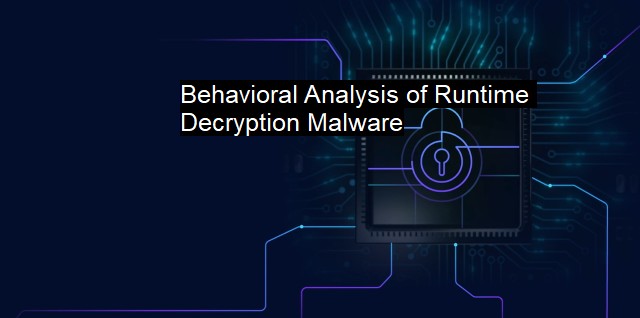What is Behavioral Analysis of Runtime Decryption Malware?
Uncovering Hidden Threats: The Importance of Behavioral Analysis in Runtime Decryption Malware Detection for Cybersecurity and Antivirus
The phrase "Behavioral Analysis of Runtime Decryption Malware" is one that encompasses the concepts of malicious software threats in the cyber arena. Malware, a derivative of malicious software, is any software formulated to intentionally cause harm to a device, server, client, or entire computer network. This can be extremely detrimental particularly in the context of antivirus software.In the cybersecurity landscape, malware is classified into various types based on its nature and its mode of attack. Among them, a specific category of malware has the potential to encrypt itself in order to camouflage the malevolent code it possesses. This tucked away code is only decrypted during the runtime, hence the term 'Runtime Decryption Malware'.
The coding legend behind malware is deceptive in itself but when decoded at the runtime, it presents an additional challenge for antivirus software to combat such malware-analogous threats. To tackle this unfamiliar yet menacing front of encrypted malware, cybersecurity and antivirus realms necessitate something more potent than traditional endpoint security measures.
Enter the Behavioral Analysis of Runtime Decryption Malware – a technique that cybersecurity professionals employ to identify and establish boundaries against this particular malware type.
At a basic level, behavioral analysis involves observing and recording the behavior of malware. The primary objective here is to discover any discrepancies in computing operations and potentially irregular occurrences. Runtime decryption malware typically reveals itself by attempting actions that wouldn't typically occur during a computer's normal operations, such as amending crucial system settings or launching unauthorized executables.
Antivirus programs use this uncharacteristic behavior to detect malware in real-time, effectively identifying the malicious code as it deciphers and exposes itself to perform the planned operation. Applying behavioral analysis on runtime decryption malware intensifies the capability of antivirus software, allowing them to recognize dynamically changing malware patterns.
Apart from observing asynchronous functions and operations of the system, behavioral analysis also scrutinizes the interaction of malware with the network. Elements like monitoring the domain names to which malware seeks to communicate or scrutinizing the flow of data to and from unidentified IP addresses help in identifying the source of the encrypted malware and subsequently contain the possibility of the system being violated.
Another aspect of the behavioral analysis is the observation and mapping of API (Application Programming Interface) calls. In computer programming, an API allows two software applications to communicate with each other. By decoding and analyzing the response and communication via API calls, experts can predict and prepare for potential cyber threats from runtime decryption malware.
The implementation of behavioral analysis therapy in the context of runtime decryption malware in cybersecurity and antivirus evolves with the shifting techno-dynamics. In light of the dynamic nature of the cyber threat landscape, the antivirus and cybersecurity industry continuously explores skillful amalgamations of artificial intelligence and machine learning in behavioral analysis. This allows not only unmasking fallacious code masked within layers of encrypted malware but also offer real-time protection against any incursion attempts.
Even though the detection and containment of malware become an onerous task due to its encryption, behavioral analysis offers an effective way to expose malware behavior and discrepancies that tradition methods might overlook. Consequently, a behavioral analysis of runtime decryption malware is an indispensable aspect of progressive cybersecurity models.

Behavioral Analysis of Runtime Decryption Malware FAQs
What is behavioral analysis of runtime decryption malware?
Behavioral analysis of runtime decryption malware is a technique used in cybersecurity to understand the behavior of malware that uses runtime decryption to evade detection. This analysis involves monitoring the behavior and activities of the malware, such as its network traffic, file access patterns, system calls, and other activities, to identify its malicious activities and potential impact on the system.Why is behavioral analysis important in detecting runtime decryption malware?
Behavioral analysis is important in detecting runtime decryption malware because traditional signature-based detection methods are often ineffective against them. These malware variants are designed to evade detection by encrypting some of their code and decrypting it at runtime, making it difficult for antivirus software to detect. By analyzing the behavior of the malware, security professionals can identify its malicious activities and protect against it.What are the challenges of behavioral analysis of runtime decryption malware?
One of the main challenges of behavioral analysis of runtime decryption malware is the complexity of the malware code. These malware variants often use multiple layers of encryption and obfuscation to evade detection, which makes it difficult to reverse engineer and analyze their behavior. Additionally, some malware may have polymorphic or metamorphic behavior, where they change their code and behavior on each execution, making them even harder to detect.How can organizations use behavioral analysis to protect against runtime decryption malware?
Organizations can use behavioral analysis to protect against runtime decryption malware by using security tools that employ this technique, such as endpoint detection and response (EDR) solutions. These tools can monitor system behavior and detect anomalous activities that may indicate the presence of malware. Additionally, organizations can improve their security posture by implementing best practices, such as user education, network segmentation, and regularly updating antivirus software and other security tools.| | A | | | B | | | C | | | D | | | E | | | F | | | G | | | H | | | I | | | J | | | K | | | L | | | M | |
| | N | | | O | | | P | | | Q | | | R | | | S | | | T | | | U | | | V | | | W | | | X | | | Y | | | Z | |
| | 1 | | | 2 | | | 3 | | | 4 | | | 7 | | | 8 | | |||||||